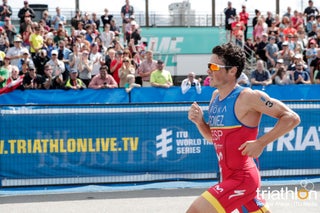

Dealing with constant IT Band Pain? You’re not alone. Dr. Jordan Metzl discusses the symptoms, as well as how to fix it and prevent it in the future.
The Symptoms
Hip or knee pain, or both. Specifically, pain on the outer side of the knee where the bone bumps out above the joint, or on the outer side of the hip. The pain usually starts after 10 minutes of running. Walking usually causes no pain.
What’s Going On In There?
The iliotibial band (ITB) is a thick tendon that runs the length of and connects the tensor fascia lata muscle—which starts on the outer side of the hip—to the outer side of the tibia, the major bone in the lower leg.
Here’s how the pain happens: A small, fluid-filled sac called a bursa sits between the tendon and the outside of the femur near the knee. You also have a bursa at the hip joint. When the ITB is tight, it increases the tension on the outer sides of the hip and knee. The ITB then pinches these two sites and the bursa (one or both) swells. Over time, the bursa becomes enlarged—big enough to cause pain every time you begin to run (which is why pain usually starts within 10 minutes of activity).
Fix it
• Roll it: A 6-by-36-inch foam roller is the best tool for stretching the ITB. Lie on your side with the roller under your leg and roll it from your hip to your knee (see right), using your body weight to knead the area. The pressure will help loosen the tendon and the fascia, almost like a self-massage. Do this at least once a day for several minutes, and make it a permanent part of your exercise activity.
• Beef up your glutes and hips. Weak butt and hip muscles contribute to ITB impingement syndrome. Make sure your lower-body work includes squats, especially single-leg squats, as well as multidirectional lunges (for more ideas, see exercises and stretches below).
• Having a properly fitted bike can help triathletes who suffer from ITB impingement while riding.
Prevent It
Build up your glutes to reinforce the body’s largest and potentially most powerful muscle group. The stretches and exercises here all help build up your glutes and hip flexors, and can be added to any workout.
Lying Glute Stretch
Lie face-up on the floor with your knees and hips bent. Cross your right leg over your left so that your right ankle sits across your left thigh. Grab your right knee with both hands and pull it toward the middle of your chest until you feel a comfortable stretch in your glutes. Hold for 30 seconds, then repeat on the opposite side. Repeat twice for a total of three sets—and several times a day if you’re really tight.
Lateral Band Walks
Place both legs between a mini-band and position the band just above your knees. Take small steps to your right for 20 feet. Then sidestep back to your left for 20 feet. That’s one set.
Hip Raise
Lie face-up on the floor with your knees bent and your feet flat on the floor. Place your arms out to your sides at 45-degree angles, your palms facing up. Raise your hips so your body forms a straight line from your shoulders to your knees. Squeeze your glutes as you raise your hips. Make sure you’re pushing with your heels. To make it easier, you can position your feet so that your toes rise off the floor. Pause for five seconds in the up position, then lower your body back to the starting position.
New York City sports medicine specialist Jordan D. Metzl, M.D. is a 29-time marathon runner and 10-time Ironman finisher. His book, The Athlete’s Book of Home Remedies, has more than 1,000 tips to fix all types of injuries and conditions.
RELATED – Ask The Running Doc: How Do I Get Rid Of IT Band Syndrome?


Original article and pictures take http://triathlon.competitor.com/2013/04/training/it-band-pain-stretches-treatment-and-prevention_74117 site

Комментариев нет:
Отправить комментарий